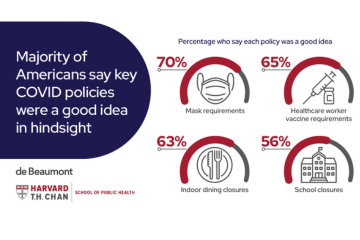The state and local governmental public health workforce may see high turnover as a result of the COVID-19 pandemic, according to an article published July 21 in the Centers for Disease Control and Prevention’s Morbidity and Mortality Weekly Report (MMWR). The article reports on findings from the new Public Health Workforce Interests and Needs Survey (PH WINS), conducted by the de Beaumont Foundation and the Association of State and Territorial Health Officials. The survey gathered the perceptions of nearly 45,000 employees in state and local health departments, covering job satisfaction, intent to leave, demographics, training needs, and other topics. Preliminary findings on stress and burnout in the workforce were released in March.
The PH WINS survey was previously conducted in 2014 and 2017, and the findings from the 2021 survey are notable because responses were collected between September 2021 and January 2022 and asked about experiences and perceptions since March 2020, when the World Health Organization (WHO) declared COVID-19 a pandemic and the United States declared the virus a national emergency. The MMWR reported on employees’ roles during the pandemic, their intent to leave or stay, and demographics such as age, gender, and race/ethnicity.
The article states: “Survey findings highlight the importance of focused attention on recruitment and retention that promotes diversity and workers with public health experience, which will be critical as the workforce rebuilds as the COVID-19 pandemic evolves.”
The article outlines key demographic information on the workforce, noting that most public health workers self-identify as white (54%), as women (79%), and as age 40 or older (63%). The article points out several differences in the responses from state health agencies, large local health departments, and medium-size local departments. For example, in medium health departments, women make up 83% of the workforce, compared with 79% and 76% at large health departments and state agencies, respectively.
Also, larger local health departments have the most racial/ethnic diversity, with fewer than half of workers identifying as white (41%), compared with about two-thirds in medium departments (66%) and state agencies (66%). Looking at professional levels, 54% of all respondents identified as white, while among executives, 66% identified as white – 78% at medium local health departments and 74% in state agencies.
Other Findings:
- 72% of respondents reported that they worked in a COVID-19 response role at some point between March 2020 and January 2022.
- Excluding retirements, 27% of public health employees reported they were considering leaving their organization within the year. Looking further out, 44% said they are considering leaving to retire or for other reasons within five years. Among those considering leaving, 76% said they began thinking about leaving after the start of the pandemic.
- The top three needs reported by workers to effectively respond to COVID-19 in their jurisdiction were additional staff capacity (51%), more community support (30%), and more support from elected leaders (26%).
The article points to several challenges and opportunities for the public health workforce.
Turnover
The large percentage of people who said they’re considering leaving is concerning, given that the workforce is already stretched, the article says. A recent report found that public health departments need about 80,000 additional full-time staff members to provide foundational public health services. “With the public health system facing immense pressure because of the prolonged COVID-19 response, worsening national health, increased stress, and burnout,” the article notes, “potential significant staff losses would further strain an overtasked workforce.
Diversity
With 54% of employees identifying as white, the governmental public health workforce is more racially and ethnically diverse than the overall U.S. workforce, which is 77% white. But there is less diversity at senior levels; 66% of executives are white. The article notes: “Diversity at all supervisory levels can facilitate a fuller understanding of the needs of culturally diverse communities. The disproportionate impact that COVID-19 has had on racial and ethnic minority communities underscores the importance of a highly diverse workforce that can better fulfill the essential and emergent needs of all communities.”
Experience
Nearly half of all respondents have been working at their organization for five or fewer years, and about one-third have been in the public health field for five or fewer years. “Findings indicate that the COVID-19 pandemic might have been many employees’ first experience with a public health emergency,” the article says. “Coupled with the high percentage of the workforce reporting an intention to leave their organization, agencies might have limited institutional knowledge from the COVID-19 pandemic response for future emergencies.”
The article’s authors recommend that agencies increase partnerships with academia to improve recruitment efforts in order to expand and diversify the workforce. Hiring surges that occur during emergencies like the pandemic provide needed capacity, they say, but do not attract people with the knowledge and expertise needed for a comprehensive response. Other recommendations include increasing efforts to retain experienced and skilled employees and addressing stress, burnout, and other factors in the workplace.
The article concludes: “PH WINS provides a snapshot of the public health workforce during a period of unprecedented and prolonged emergency response. It is critical that workforce development efforts prioritize purposeful succession planning and recruitment and retention efforts that increase diversity as the workforce fortifies and rebuilds after the COVID-19 pandemic.”




